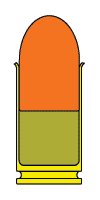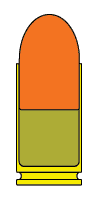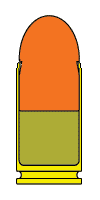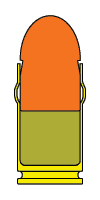So, I'm thinking there is little to no crimp. What else might cause the problem, given the symptoms?
It isn't the "crimp". I put it in quotes because a taper crimp isn't a crimp, it's a bell removal.
Let me illustrate (I drew these at work in anticipation of your reply):
Here's an uncrimped round:
The top of the case is still belled away from the bullet. This round will likely not chamber. The bullet is held in place by the bearing surface of the case against the bullet.
Here's a properly crimped round:
Note that the top of the case is flat against the bullet, and the bullet is not deformed. Again, the bullet is held in place by the bearing surface of the case against the bullet. Any additional increase in "hold" provided by the crimp is minimal - it's whatever additional hold the roughly .020" of case that was previously belled away can provide. You can see that this additional bearing surface represents less than 10% of the bullet-to-case contact area. The relationship between friction and area is not linear, so this doesn't even add that much to the hold.
Here's an overcrimped round (drawn slightly exaggerated):
What has happened is that the overcrimp has deformed the bullet. Cartridge brass and lead have different moduli of elasticity. The lead's modulus of elasticity has been exceeded and it has been permanently deformed. In addition, the lead inside the jacket displaces up and down, taking the copper with it. The copper that has to bridge the "canyon" between the humps of displaced lead is also stretched enough during the crimp so that
it exceeds its modulus of elasticity, and it "sets". Cartridge brass is intentionally "springy", otherwise we'd never be able to extract a case after it was fired (it expands to seal the chamber then contracts a bit to allow extraction). The modulus of elasticity for the brass has not been exceeded, and it springs back, leaving a gap between the case and the bullet at the top of the case. There is actually less hold than if you never crimped it. Note that you would not see this by looking at the round.
Here's a severely overcrimped round:
This is what happens when you severely overcrimp a round using one of those dies that will taper crimp at first but roll crimp when you crank it down (like a Lee seating die). In addition to the bullet deformation (and brass springback) noted above, the brass has bulged away from the base of the bullet, greatly reducing the "hold".
A Lee factory crimp die will correct this condition so that the cartridge will chamber, but the bullet deformation will remain, and you're still getting less hold than you would with a good crimp. The only way to get better hold on loose autoloader bullets is to use an undersized sizing die. I got one for R-P cases because they hold weakly.
As to the OP's problem: My guess would be that his powder got hot at some point in it's life and is partially spoiled.
![Thinking [thinking] [thinking]](/xen/styles/default/xenforo/smilies.vb/010.gif)
![Thinking [thinking] [thinking]](/xen/styles/default/xenforo/smilies.vb/010.gif)






![Wink [wink] [wink]](/xen/styles/default/xenforo/smilies.vb/002.gif)
![Roll Eyes [rolleyes] [rolleyes]](/xen/styles/default/xenforo/smilies.vb/042.gif)
![Grin [grin] [grin]](/xen/styles/default/xenforo/smilies.vb/041.gif)